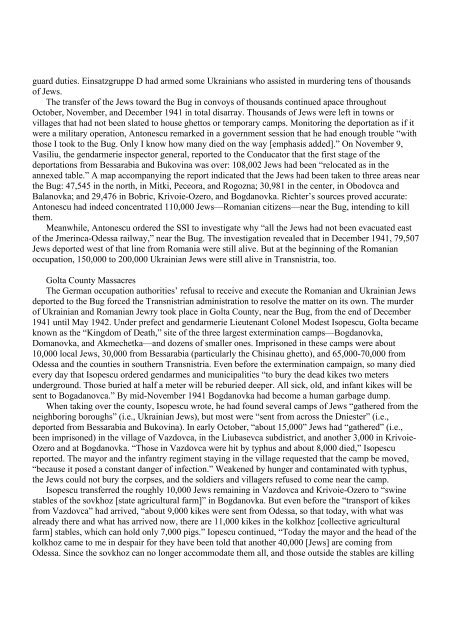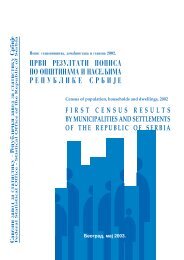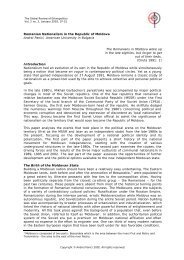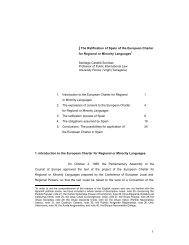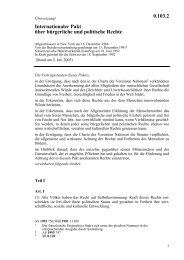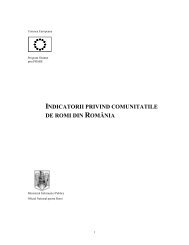Final Report of the International Commission on the - Minority Rights ...
Final Report of the International Commission on the - Minority Rights ...
Final Report of the International Commission on the - Minority Rights ...
You also want an ePaper? Increase the reach of your titles
YUMPU automatically turns print PDFs into web optimized ePapers that Google loves.
guard duties. Einsatzgruppe D had armed some Ukrainians who assisted in murdering tens <str<strong>on</strong>g>of</str<strong>on</strong>g> thousands<br />
<str<strong>on</strong>g>of</str<strong>on</strong>g> Jews.<br />
The transfer <str<strong>on</strong>g>of</str<strong>on</strong>g> <str<strong>on</strong>g>the</str<strong>on</strong>g> Jews toward <str<strong>on</strong>g>the</str<strong>on</strong>g> Bug in c<strong>on</strong>voys <str<strong>on</strong>g>of</str<strong>on</strong>g> thousands c<strong>on</strong>tinued apace throughout<br />
October, November, and December 1941 in total disarray. Thousands <str<strong>on</strong>g>of</str<strong>on</strong>g> Jews were left in towns or<br />
villages that had not been slated to house ghettos or temporary camps. M<strong>on</strong>itoring <str<strong>on</strong>g>the</str<strong>on</strong>g> deportati<strong>on</strong> as if it<br />
were a military operati<strong>on</strong>, Ant<strong>on</strong>escu remarked in a government sessi<strong>on</strong> that he had enough trouble “with<br />
those I took to <str<strong>on</strong>g>the</str<strong>on</strong>g> Bug. Only I know how many died <strong>on</strong> <str<strong>on</strong>g>the</str<strong>on</strong>g> way [emphasis added].” On November 9,<br />
Vasiliu, <str<strong>on</strong>g>the</str<strong>on</strong>g> gendarmerie inspector general, reported to <str<strong>on</strong>g>the</str<strong>on</strong>g> C<strong>on</strong>ducator that <str<strong>on</strong>g>the</str<strong>on</strong>g> first stage <str<strong>on</strong>g>of</str<strong>on</strong>g> <str<strong>on</strong>g>the</str<strong>on</strong>g><br />
deportati<strong>on</strong>s from Bessarabia and Bukovina was over: 108,002 Jews had been “relocated as in <str<strong>on</strong>g>the</str<strong>on</strong>g><br />
annexed table.” A map accompanying <str<strong>on</strong>g>the</str<strong>on</strong>g> report indicated that <str<strong>on</strong>g>the</str<strong>on</strong>g> Jews had been taken to three areas near<br />
<str<strong>on</strong>g>the</str<strong>on</strong>g> Bug: 47,545 in <str<strong>on</strong>g>the</str<strong>on</strong>g> north, in Mitki, Peceora, and Rogozna; 30,981 in <str<strong>on</strong>g>the</str<strong>on</strong>g> center, in Obodovca and<br />
Balanovka; and 29,476 in Bobric, Krivoie-Ozero, and Bogdanovka. Richter’s sources proved accurate:<br />
Ant<strong>on</strong>escu had indeed c<strong>on</strong>centrated 110,000 Jews—Romanian citizens—near <str<strong>on</strong>g>the</str<strong>on</strong>g> Bug, intending to kill<br />
<str<strong>on</strong>g>the</str<strong>on</strong>g>m.<br />
Meanwhile, Ant<strong>on</strong>escu ordered <str<strong>on</strong>g>the</str<strong>on</strong>g> SSI to investigate why “all <str<strong>on</strong>g>the</str<strong>on</strong>g> Jews had not been evacuated east<br />
<str<strong>on</strong>g>of</str<strong>on</strong>g> <str<strong>on</strong>g>the</str<strong>on</strong>g> Jmerinca-Odessa railway,” near <str<strong>on</strong>g>the</str<strong>on</strong>g> Bug. The investigati<strong>on</strong> revealed that in December 1941, 79,507<br />
Jews deported west <str<strong>on</strong>g>of</str<strong>on</strong>g> that line from Romania were still alive. But at <str<strong>on</strong>g>the</str<strong>on</strong>g> beginning <str<strong>on</strong>g>of</str<strong>on</strong>g> <str<strong>on</strong>g>the</str<strong>on</strong>g> Romanian<br />
occupati<strong>on</strong>, 150,000 to 200,000 Ukrainian Jews were still alive in Transnistria, too.<br />
Golta County Massacres<br />
The German occupati<strong>on</strong> authorities’ refusal to receive and execute <str<strong>on</strong>g>the</str<strong>on</strong>g> Romanian and Ukrainian Jews<br />
deported to <str<strong>on</strong>g>the</str<strong>on</strong>g> Bug forced <str<strong>on</strong>g>the</str<strong>on</strong>g> Transnistrian administrati<strong>on</strong> to resolve <str<strong>on</strong>g>the</str<strong>on</strong>g> matter <strong>on</strong> its own. The murder<br />
<str<strong>on</strong>g>of</str<strong>on</strong>g> Ukrainian and Romanian Jewry took place in Golta County, near <str<strong>on</strong>g>the</str<strong>on</strong>g> Bug, from <str<strong>on</strong>g>the</str<strong>on</strong>g> end <str<strong>on</strong>g>of</str<strong>on</strong>g> December<br />
1941 until May 1942. Under prefect and gendarmerie Lieutenant Col<strong>on</strong>el Modest Isopescu, Golta became<br />
known as <str<strong>on</strong>g>the</str<strong>on</strong>g> “Kingdom <str<strong>on</strong>g>of</str<strong>on</strong>g> Death,” site <str<strong>on</strong>g>of</str<strong>on</strong>g> <str<strong>on</strong>g>the</str<strong>on</strong>g> three largest exterminati<strong>on</strong> camps—Bogdanovka,<br />
Domanovka, and Akmechetka—and dozens <str<strong>on</strong>g>of</str<strong>on</strong>g> smaller <strong>on</strong>es. Impris<strong>on</strong>ed in <str<strong>on</strong>g>the</str<strong>on</strong>g>se camps were about<br />
10,000 local Jews, 30,000 from Bessarabia (particularly <str<strong>on</strong>g>the</str<strong>on</strong>g> Chisinau ghetto), and 65,000-70,000 from<br />
Odessa and <str<strong>on</strong>g>the</str<strong>on</strong>g> counties in sou<str<strong>on</strong>g>the</str<strong>on</strong>g>rn Transnistria. Even before <str<strong>on</strong>g>the</str<strong>on</strong>g> exterminati<strong>on</strong> campaign, so many died<br />
every day that Isopescu ordered gendarmes and municipalities “to bury <str<strong>on</strong>g>the</str<strong>on</strong>g> dead kikes two meters<br />
underground. Those buried at half a meter will be reburied deeper. All sick, old, and infant kikes will be<br />
sent to Bogadanovca.” By mid-November 1941 Bogdanovka had become a human garbage dump.<br />
When taking over <str<strong>on</strong>g>the</str<strong>on</strong>g> county, Isopescu wrote, he had found several camps <str<strong>on</strong>g>of</str<strong>on</strong>g> Jews “ga<str<strong>on</strong>g>the</str<strong>on</strong>g>red from <str<strong>on</strong>g>the</str<strong>on</strong>g><br />
neighboring boroughs” (i.e., Ukrainian Jews), but most were “sent from across <str<strong>on</strong>g>the</str<strong>on</strong>g> Dniester” (i.e.,<br />
deported from Bessarabia and Bukovina). In early October, “about 15,000” Jews had “ga<str<strong>on</strong>g>the</str<strong>on</strong>g>red” (i.e.,<br />
been impris<strong>on</strong>ed) in <str<strong>on</strong>g>the</str<strong>on</strong>g> village <str<strong>on</strong>g>of</str<strong>on</strong>g> Vazdovca, in <str<strong>on</strong>g>the</str<strong>on</strong>g> Liubasevca subdistrict, and ano<str<strong>on</strong>g>the</str<strong>on</strong>g>r 3,000 in Krivoie-<br />
Ozero and at Bogdanovka. “Those in Vazdovca were hit by typhus and about 8,000 died,” Isopescu<br />
reported. The mayor and <str<strong>on</strong>g>the</str<strong>on</strong>g> infantry regiment staying in <str<strong>on</strong>g>the</str<strong>on</strong>g> village requested that <str<strong>on</strong>g>the</str<strong>on</strong>g> camp be moved,<br />
“because it posed a c<strong>on</strong>stant danger <str<strong>on</strong>g>of</str<strong>on</strong>g> infecti<strong>on</strong>.” Weakened by hunger and c<strong>on</strong>taminated with typhus,<br />
<str<strong>on</strong>g>the</str<strong>on</strong>g> Jews could not bury <str<strong>on</strong>g>the</str<strong>on</strong>g> corpses, and <str<strong>on</strong>g>the</str<strong>on</strong>g> soldiers and villagers refused to come near <str<strong>on</strong>g>the</str<strong>on</strong>g> camp.<br />
Isopescu transferred <str<strong>on</strong>g>the</str<strong>on</strong>g> roughly 10,000 Jews remaining in Vazdovca and Krivoie-Ozero to “swine<br />
stables <str<strong>on</strong>g>of</str<strong>on</strong>g> <str<strong>on</strong>g>the</str<strong>on</strong>g> sovkhoz [state agricultural farm]” in Bogdanovka. But even before <str<strong>on</strong>g>the</str<strong>on</strong>g> “transport <str<strong>on</strong>g>of</str<strong>on</strong>g> kikes<br />
from Vazdovca” had arrived, “about 9,000 kikes were sent from Odessa, so that today, with what was<br />
already <str<strong>on</strong>g>the</str<strong>on</strong>g>re and what has arrived now, <str<strong>on</strong>g>the</str<strong>on</strong>g>re are 11,000 kikes in <str<strong>on</strong>g>the</str<strong>on</strong>g> kolkhoz [collective agricultural<br />
farm] stables, which can hold <strong>on</strong>ly 7,000 pigs.” Iopescu c<strong>on</strong>tinued, “Today <str<strong>on</strong>g>the</str<strong>on</strong>g> mayor and <str<strong>on</strong>g>the</str<strong>on</strong>g> head <str<strong>on</strong>g>of</str<strong>on</strong>g> <str<strong>on</strong>g>the</str<strong>on</strong>g><br />
kolkhoz came to me in despair for <str<strong>on</strong>g>the</str<strong>on</strong>g>y have been told that ano<str<strong>on</strong>g>the</str<strong>on</strong>g>r 40,000 [Jews] are coming from<br />
Odessa. Since <str<strong>on</strong>g>the</str<strong>on</strong>g> sovkhoz can no l<strong>on</strong>ger accommodate <str<strong>on</strong>g>the</str<strong>on</strong>g>m all, and those outside <str<strong>on</strong>g>the</str<strong>on</strong>g> stables are killing


